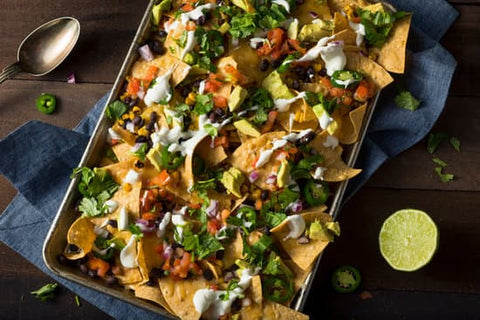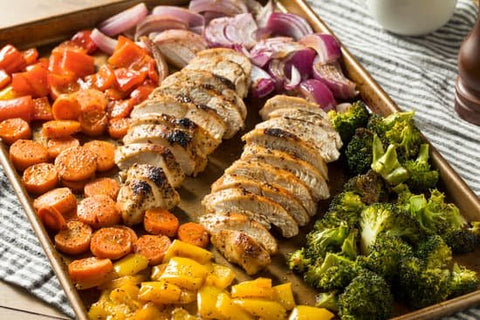May 07, 2020
There’s a new trend in cooking: sheet pan meals.
The sheet-pan approach is that the foods are roasted, not simmered together.
This is healthy eating. Plus, the roasting caramelizes the vegetables.
As an added bonus, sheet pan cooking creates very few dishes for washing up.
Quick, delicious, and easy (in planning, preparing, and clean-up) sheet pan dinners can be built a million ways and are completely customizable to your family’s favourites.

And once you start crafting your own combinations of protein, vegetable, herbs, and sauce, you will be hooked on this foolproof technique.
Here are 10 tips to get you started:
The right baking sheet to use for sheet pan dinners is called a half-sheet pan. It's made of heavy-gauge metal, measures 45 cm x 33cm (18 by 13 inches), and has a 2.5cm (1-inch) rim all the way around.
It's sturdy enough to take high oven heat--and sometimes broiler heat.
The size allows for ingredients to be spread out so you don't crowd the pan. (Crowded pans make for mushy meals because the ingredients steam instead of roast.)
The rim is low enough for the heat to move across the ingredients to give them a crisp, brown, caramelized finish.
Line the pan with heavy-duty foil or parchment paper (not waxed paper). You might have to do a little light washing later, but a well-lined pan cleans up in a jiffy.
To speed up the cook-time, and ensure that your vegetables get a good sear right off the bat, stick your baking sheet in the oven as the oven preheats.
By the time you're ready to add the vegetables, the pan will be sizzling-hot, as if you were adding them to a hot skillet. "Not only does this jump-start the cooking process and decrease the total roasting time but it also assures you'll get caramelized crispy edges and even charred bits.
If you want to build a sheet-pan dinner, you have to be a smart roasting matchmaker.
Because if you set up proteins and veggies on hot dates in the oven that finish cooking at radically different speeds, you’ll have a bit of a hot mess on your hands of burnt green beans next to perfectly cooked chicken thighs.
Set up vegetables and proteins that will be happy hanging out in the same temperature oven for the same amount of time.
Those green beans will cook at the same rate as a fish fillet—try pairing them with halibut for a roasted take on Nicoise salad.
And with those chicken thighs? Try hearty whole carrots—they’ll be done at the exact same time.
Don’t torture yourself trying to fit everything onto one sheet-pan just so you can say you cooked the entire meal on one sheet pan.
Sometimes, two sheet-pans will afford you greater control and giving you the freedom to make different combinations
Think beyond roasting and eating every element of your sheet-pan dinner exactly as it comes off the sheet-pan— try transforming part of it into a sauce.
That could be as simple as roasting a head of garlic in the corner of the sheet-pan that you whisk into mayo for a cheater’s aioli, or it could be as advanced as roasting salsa ingredients alongside chicken and squash to blend into a salsa-like dish

Cut vegetables to the same size and shape (too large and they won’t cook through, too small and they’ll burn).
Look for meat cuts of the same thickness so they’ll cook evenly.
Excess water is the enemy of sheet pan cooking because the oven has to work harder to evaporate moisture before it can brown and cook the food. Pat meat and rinsed veggies dry before cooking.
To ensure that vegetables don't dry out while they're cooking, make sure you completely coat them with oil.
The best way to do this is by putting them into a large bowl and adding the oil and any other seasonings in your recipe. Then stir with a spoon or with your hands to cover everything thoroughly.
A smart move is to do the dense vegetables first, then use what's in the bowl to coat the softer vegetables that will be added to the pan later.
This list outlines some complementary ingredients pairings based on cooking time and oven temperature. You’ll also want the vegetables you’re cooking together to be more-or-less the same size to promote even cooking.
205° C (400° F) for 20 to 30 minutes
Veg: cabbage, carrots, turnips, radicchio, apples
Protein: pork chops
205° C (400° F) for 35 to 40 minutes
Veg: bell peppers, onions, sweet potatoes,
Protein: sausages (pork, chicken, lamb)
220° C (425° F) for 15 minutes
Veg: bok choy, green beans, scallions, mushrooms, greens, tomatoes, zucchini, leeks, asparagus, lemon rounds
Protein: fish (salmon fillets, large white fish fillet)
220° C (425° F) for 20 to 30 minutes
Veg: green beans, eggplant, bell peppers, scallions
Protein: tofu
220° C (425° F) for 35 to 45 minutes
Veg: potatoes, fennel, squash, beets, Brussels sprouts, onions, broccoli, cauliflower, eggplant, orange rounds
Protein: chicken pieces (bone-in)
These 10 tips should get you started in trying sheet pan dinners.
Additional Reading
Comments will be approved before showing up.
August 14, 2024
January 10, 2024
July 03, 2023

